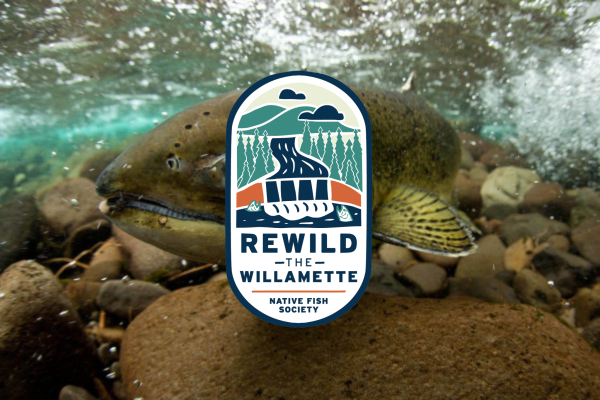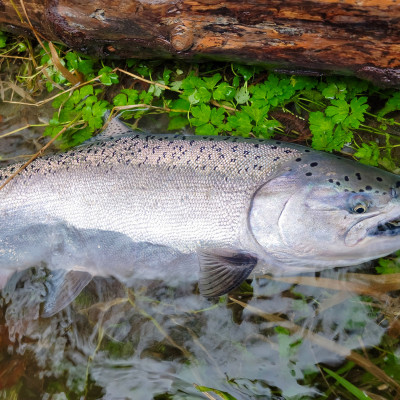Native Fish Society is fighting to recover Oregon's most imperiled wild fish by building a groundswell of public support to advocate for effective fish passage at the 13 federally owned and operated dams in the basin. And we are holding the management agencies accountable in court, assuring that they take action now to provide relief to struggling populations and ensuring that they develop and implement a long-term plan to recover the species.
Willamette fish provide a multitude of benefits including supporting healthy ecosystems that supply drinking water to our communities, the cultural heritage needs of indigenous people and tribal nations, and commercial and recreational fishing economies. The Willamette River in Oregon flows 180 miles out of the Cascades and Coast Range Mountains to its confluence with the Columbia River in the city of Portland. The river drains 11,487 square miles, nearly 12% of the state, flowing through a wide, fertile valley that is home to 75% of Oregon’s population and is the state’s agricultural powerhouse. The Willamette has been important to many Native American tribes that have relied on the river for millennia for salmon, as a trading hub, and as a source of water and other critical resources.
Restoring natural processes that have been altered by dams will benefit our fish, our ecosystems, and our communities that depend on these homewaters.
For a detailed story about this issue, please take a moment to read this excellent piece by ProPublica dealing with all the issues surrounding the Army Corps' management of the Willamette Basin dams.
The Threat:
Built and operated by the U.S. Army Corps of Engineers, a network of thirteen dams are located throughout the Willamette basin blocking access to critical salmon and steelhead spawning habitat. Adult Chinook and steelhead cannot get over the dams—there are no functioning fish ladders. Juvenile fish struggle to migrate downstream through the large reservoirs and often cannot move past the dams without being forced through turbines.
Along with the physical barriers these dams impose, they further harm fish and the river by altering natural flows, contributing to diminished water quality, and degrading riparian environments.
Because Willamette Chinook and steelhead are listed as threatened under the Endangered Species Act, the Army Corps has a duty to ensure the dams do not jeopardize their survival and recovery. National Marine Fisheries Service issued a complete list of actions in 2008, identified in a Biological Opinion, that the Army Corps must take to protect these species and ensure recovery. The agency said that the critical actions needed to recover Willamette salmon and steelhead are fish passage for adults & juveniles, improved water temps & flows downstream of dams, downstream habitat restoration, and completed Hatchery Genetic Management Plans.
Over ten years later, many of the required actions have not been undertaken. Many of the deadlines in the Biological Opinion and agreed to by the Army Corps have been missed. The result: Willamette salmon and steelhead populations are circling the drain.
In 2018, fewer than 5,000 wild spring Chinook and less than 1,000 wild winter steelhead made it back to the river. This represents just one to two percent of the historic populations that once returned to spawn in the system’s cold, forested streams like the Molalla, Santiam and McKenzie Rivers.
Willamette salmon and steelhead face a high probability of disappearing forever with a ninety-nine percent chance of local extinction in some tributaries by 2040. Without drastic action now, we will lose these icons of our landscapes and northwest heritage forever.
Key problems caused by dams:
1) Lack of passage:
In the mid 1900’s, the Corps built a series of thirteen dams throughout the basin with the primary purpose of flood control. These dams failed to provide fish passage along the east side of the Willamette Valley, thus blocking access to much of the highest quality habitat in the most historically productive systems. This further diminished wild fish populations already stressed by the impacts of hatchery competition, overharvest, and habitat destruction. The North Santiam, once home to an estimated 23% of the Willamette's spring Chinook and 34% of systems winter steelhead, lost an estimated 70% of its anadromous fish habitat with the construction of the Big Cliff and Detroit dams.
Of key importance is establishing effective downstream passage for juvenile fish attempting to migrate to the ocean. The reservoirs created by dam operations and the lack of safe and effective passage through the dams has been identified in the Biological Opinion as a significant barrier to recovery.
2) Altered flows:
Operation of dams for flood control and other purposes, including hydropower and recreation, have resulted in unnatural flow patterns downstream of Corps projects. Historical dam operations result in a reduction of natural flows in the spring, when fish need higher flows for downstream and upstream migration and higher summer and early fall flows that can dewater redds when river levels drop in late fall and early winter.
3) Water quality impacts:
Discharge from the dams has resulted in unseasonable water temperatures degrading the aquatic habitat below, diminishing potential for both spawning and rearing of salmon, altering the biological timing of key lifecycle processes, and resulting in high rates of pre-spawn mortality. Operational adjustments at several dams including Detroit Dam have resulted in some improvement to water temperatures in downstream reaches. A Water Temperature Control Tower has been proposed to fully meet the downstream temperature needs of the North Santiam but is significantly behind schedule while a temperature control facility has been built and is operational for Cougar Dam on the McKenzie River.
Our key area of focus for the Willamette River is Hydropower. Learn more about the science behind the 5 H’s and their importance to the revival of wild abundance here.
Our Goals:
Reverse the decline of threatened wild winter steelhead and spring Chinook salmon in the Upper Willamette River basin by:
Establishing effective adult and juvenile passage at Army Corps dams with a focus on volitional passage.
Improving water quality, specifically temperature regimes, dissolved oxygen, and disease/parasitic loading.
Securing adequate flows and modifying flow timing.
How is NFS working to achieve our goal?
Implementing immediate operational changes at 8 dams to help fish. As an outcome of our litigation, the US District Court found that the Army Corps was violating the endangered species act. In 2021, the court issued an injunction that ordered the Army Corps to take specific actions to aid Chinook salmon and steelhead. The court also required the Army Corps to develop a new plan to guide the long-term operations of the dams in ways that will recover the species.
Eliminating commercial hydropower production. The Army Corps Dams in the Willamette Basin produce very little power at a high price. Eliminating hydropower production from the basin would allow the dams to be managed to prioritize native fish migration.
Successes & Accomplishments to Date:
MAJOR MILESTONE! Congressional directive to Corps to begin disposition study, the first step in deauthorizing hydropower production, included in the Water Resources Development Act of 2022 and signed into law via Defense Authorizations Act.
Worked in alignment with Bonneville Power Administration and the Public Power Council to draft and submit legislative language to deauthorize hydropower production.
Bonneville Power Administration (BPA) announces they are suspending funding hydropower-related maintenance and capital improvement projects on the Willamette system.
MAJOR MILESTONE! Court order directing the Army Corps to pursue explicit remedies requiring operational changes at 8 dams to benefit fish passage, water quality, and water flows. Implementation began Fall 2021.
MAJOR MILESTONE! Corps implements interim measures (outside of our litigation) at several dams with the goal of increasing downstream passage survival and efficiency, improve water quality, and restore degraded habitats.
MAJOR MILESTONE! Court rules in favor of Willamette wild fish in our litigation finding that the Army Corps violated all three of our ESA claims.
MAJOR MILESTONE! Hydropower decommissioning report requirement for Cougar and Detroit dams included in Water Resources Development Act of 2020.
MAJOR MILESTONE! Provision requiring Army Corps to comply with Willamette Basin Review Biological Opinion of 2019 included in Water Resources Development Act of 2020. This requires the Army Corps to prioritize storage water for fish needs, even in water shortage years.
Forced the Army Corps to create new operations and maintenance plan for the first time in more than three decades. This plan will require a new Biological Opinion governing the actions required of the agency to recover Willamette threatened salmon and steelhead.
Cocreated and lead the Willamette Salmon and Steelhead Recovery Coalition focused on activating members and supporters in advocating for reforms to Corps operations
Engaging Congressional offices and bringing delegation attention to fish passage, operational issues, and hydropower reform.
Successfully getting the Corps to reassess volitional fish passage at Cougar Dam
Beneficial court ruling stating that we are likely to win our case on the merits
With conservation partners and River Stewards, requested uplisting of upper Willamette fish to endangered and submitted extensive comments for the NMFS 5-year status review.
Shared our Willamette work with broad audiences through presentations and public events including a panel discussion at the Public Interest Environmental Law Conference and through virtual partnership events with our conservation partners.
How Can You Help?
Get involved!
You can help make a difference in protecting the incredible and essential Spring Chinook fish by volunteering, making a donation, or spreading the word about the importance of reviving these vital native fish. Send us a message if you have any questions, or would like to be notified of any upcoming volunteer opportunities and/or Action Alerts for the protection and revival of Spring Chinook on the Oregon Coast.




